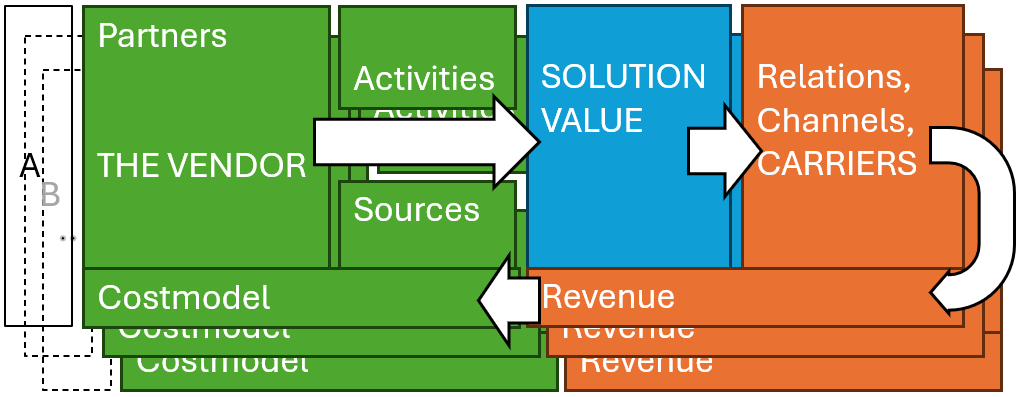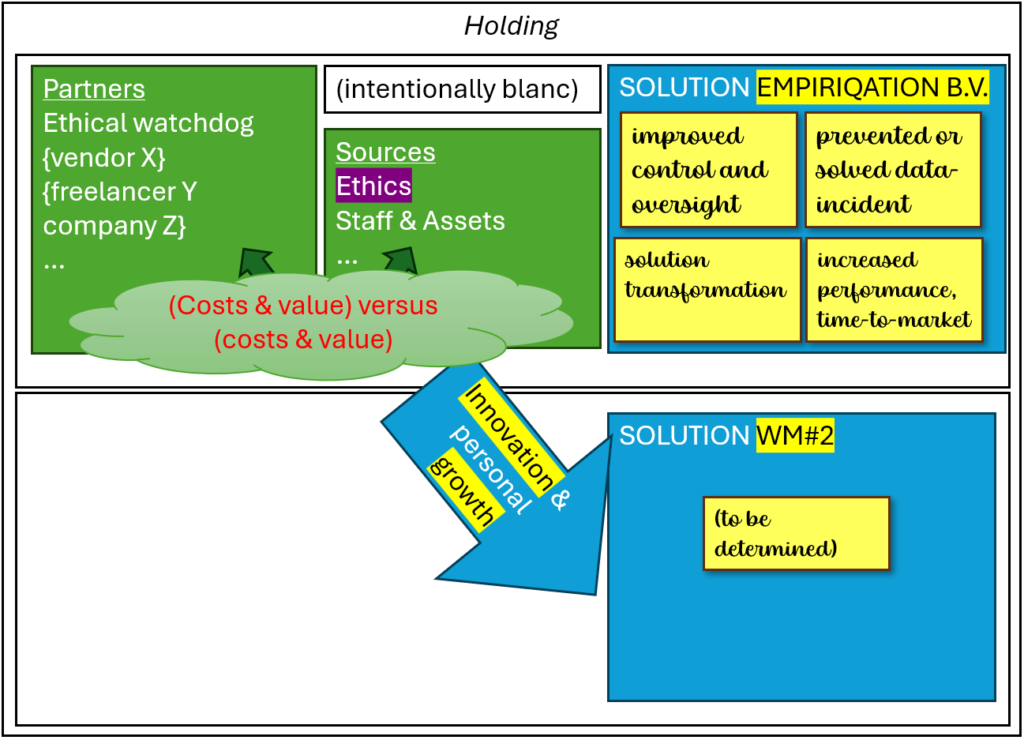What is the harsh lesson for us, consultants, who worked or still work for a system integrator? We failed, we learned, we will proudly emerge out of a shameful pitfall because we are humans AND we will bring numerous big players in industry further together with many young professionals. That can’t be said about the companies that we had to leave behind in order to grow. Those don’t have a second chance, only humans get new chances as many as necessary to grow.

Let’s explain it with 3 business models, just to make my point clear. Take three system-integrators A, B and … and one or multiple (doesn’t matter much) system-vendors “THE VENDOR”. Whether the clients (carriers) on the right side are helped by integrator A, B or … has no influence on the SOLUTION VALUE that they receive as long as the integrators don’t differ in their additional solution value (blue, middle). The only real differentiation that matters between A, B and … is the activities and the sources that provide the solution. Which is largely just people who grow and develop naturally.
From pitfall to dystopia
Now let’s assume the traditional market behavior in the above model, so that both integrator B and … try their best to reduce costs as much as possible to better serve their shareholder value. Oh my god, a nightmare dooms at the horizon! Even worse: a dystopian future is near! I feel shame for the contribution to that and happy that I’m able to turn the situation in the advantage, hopefully on time, for young professionals.
Let’s not downplay reality the way it is or gloss things over like traditional players in business gladly do. What happens when system integrators reduce costs is that natural growth of people, who deliver the blue value solutions, becomes a problem. This is caused by the complexity of multiple integrators and vendors, where clients go to the best integrator based on what they promise: either A, B or …. promises exactly the same thing which is – a solutions for the customer based on The Vendor.
Cutting on costs results in exactly the things that many ex-collogues experienced: increase in voluntary work for learning, innovation and proposals. In other words – adding value and growth/development become voluntary value and not paid business value.
Being dependent on voluntary work as a company results in the slowly but steady tumbling of the house of cards. Social or cultural differences and performance measurement of personnel becomes entangled with the expectations and accountabilities of managers, people follow customers to other integrators leaving behind knowledge gaps, new people are squeezed into the gap, putting them in between expectations and their own progression based on topics that the managers have no idea about. Collaboration with the partner deteriorates, both the vendor and integrators loose goodwill despite the correct business model. The domino effect continues with finger pointing, micro management and gaps unsolved at the clients, resulting in disputes over unsolved supply-chain issues. And how are these liabilities solved? By a defense mechanism: certification of vendor system trainings, and people hammered for ever on one position or choosing other carrier paths – leaving the vendors behind who are screaming for new blood and leaving companies hiring in their struggle to increase performance.
Recipe for A
Is there a natural solution for this business model? The answer is no. But there is another business model possible that delivers the actual solution needed, including the partnerships with vendors. Everyone can construct such a model by starting with the carriers, drawing the line backwards to activities and sources, going further backward to partners and costing model, continue following the costing model to the required revenue to make shareholders happy and comparing the required revenue with the costs and required amount of customers. Going a few circles that way provides the details for an initial kick-start, needed to pitch a nice new system integration business. The old brand names can’t be used anymore – sorry they perished in history. The original people however are experienced and return in some way in the new model, given the carrier path and talents that they already had, to play a significant role in the economy of modern society!
Model of system integration

With the above displayed subsection of the businessmodel of Empiriqation b.v., there are three factors introduced that are relevant for cultural and social wellbeing (which, by the way, carries important psychological and physical health benefits). First of all, notice the red text in the cloud which means freedom for people to contribute to the solution either as partner or as staff. If the b.v. isn’t offering long term growth expectations for someone it is perfectly possible to work together as a partner.
Secondly, notice the solutions provided based on ethics (in purple) safeguarded by an ethical watchdog as partner (in the green section). This solidifies the sustainability of freedom, decision-making based on a continual increase of dignity, propagation of critical thinking and development of people with their talents and roles into the economy of modern society (which screams for sustainability, again by the way).
Last but not least, as the provided solutions (blue) towards the clients will gradually become obsolete over time, innovations are welcome inside the expandable framework of the holding. This factor foresees in the eagerness of shareholders for new developments, thus investing in ideas that aren’t necessarily matching with the existing channels or relations. That allows people to keep intellectual property, and they can grow naturally towards new roles of modern society for new relations, if desired, without the burden of starting completely independent, if not desired. If this turns out well, it can be expected that the required knowledge is kept longer inside the framework then otherwise. This model matches well with current industry which is both slow and fast (traditional large players with legacy techniques versus new businesses based on new techniques with various successes).
Some open questions are answered in the text below, you may want to scan it for a complete argumentation for the introduction. There is just one way to prove it: doing it.
Will system integration perish?
I don’t want to go into detailed figures about the market which has shown movements of both insourcing (con S.I.) and outsourcing (pro S.I.). The gut feeling based on 25 years of observations is, that independent of the time-related movements there will always be a need for system integrators, period. This is given by a few examples below and the by absence or weakness of other examples.
Examples where a need for a system-integrator looks obvious are: all users of systems with a strong master-data dependency between ERP-systems and manufacturing systems. Many systems depend on specific versions of master data while the transition to a new ERP system version, with new features, includes an upgrade and/or shift of master data: new versions. Since historic data is stored over 5 or 10 years, reference to the old versions must co-exist with the newly introduced master-data throughout the networked systems architecture of industry 4.0 (MAKE-relevant are Manufacturing Execution on all existing lines, Historians, Advanced Planning & Scheduling, Lab Information management, R&D software, Plant simulations, Spec/Recipe management/Product design/PLM, Warehouse Management, Energy/Water/Waste Mgt). The progression of system maturity requires the phase-in and phase-out of both technical solution components, sometimes customizations, and configurations of complex data-models. Companies don’t have the new knowledge available and will either need their employees to learn things on a level that they may or may not want, or hire new employees which often takes longer than the project deadlines. Vendors can’t assist every transition on time. There you see there is always a collection of systems and players where integrators can supply the people who have the talents and interest in functional data solutions.
If we take examples of insourcing where the industrial players think “no system integrator is needed”: this idea simply shifts people with the required talents to places where they can’t serve multiple clients, which leads to a blocking situation for other clients so that integrators are still required. However if we take examples of large networks of licensed freelancers belonging to a single vendor who may think “no system integrator is needed”: these networks show a fast increase of the average age. Younger people don’t accept the limitations of a single gospel that they have to support to be part of a network. Although it may have worked for people who like adventure, such networks are subject to “the law of handicap of the head start.”. Also there are many talented people who need a predictable, secure position without too much travel.
Other examples to disprove the need of a system integrator are the bad actors where it may be demonstrated that “the system integrator is just an extension of the vendor”. They simply waited for the new version of the product by the vendor and waited for change requests or new projects: as few business consultants as possible and eliminating idle talent because they are expensive. They simply didn’t take the business model serious enough: an integrator isn’t offering the same solutions as the vendor like a pass-through. Maybe authentic integrators perform better. Finally I know there are new integrators with off-shore departments, who abuse the differences in currency value to make the same service look cheaper by taking talent from a region with lower currency value. They try to make it look like something good for these people that they earn money far away and send it home for the family. Allowing a longer holiday is just a band aid for the long absence of the family member. They may shift the blame with thinking “it is caused by the market” but it is obviously their business model that is arranged around cheaper currencies such that the solution quality is going down together with the price – regardless how hard they scream otherwise. If they read this, I want to remind them that dignity, integrity and sustainability includes that the natural family structure, socially and culturally, is priceless. If people are willing to work far away it means how bad they need to improve the local situation – taking advantage of this isn’t more sustainable but just cheaper.
Disproving something takes more breath than proving something. I hope the different examples are clear. If anyone can help with figures or examples to disprove the role of the system integrator, I’m very grateful because then I’ll take extra care.
Is this only a philosophy?
The above pitfall in the traditional business model isn’t commonly shared by integration consultants. First of all, consultants tend to cover things up or blame some of the many criteria in the economy that they can find. Also they often don’t like negativity such as shame, which is why they can’t use it openly to explain what they learned from experiencing a pitfall – so then it’s not heard. I recently discovered that admitting a failure, such as collaboration in a business model that tares you down together with your family, is found to be useful as a marketing story. So I thought, let’s describe it how I see it and maybe it turns into a nice story. Although not commonly shared, I know my story isn’t unique.
Many of my ex-colleagues actually started their own companies. Some of them even got targeted and/or legally accused by ruthless actors in the market as part of their adventure. Others have job-hopped at different customers (downwards/right in the model) or grew (upward/left in the model) at the vendors. There are a few who stayed and complain of increased pressure and lack of hands. I know a few who have quit and started other careers.
A struggle today that clouds a sense of reality, while I may just in the vanguard of a larger transition, is that there are companies who claim to strive towards sustainability while the whole supply chain can be replaced by a real ecological and sustainable supply chain and they are afraid to admit it. For a future only real sustainability counts and an unsustainable future is in fact just rephrase of the word dystopia. Reality tells what is sustainable, trust common sense! I believe we can achieve that when all talents are engaged in the transition and when critical thinking is accepted. Also, good industrial players who succeed by high performance allow to transition their raw materials by ecological friendly alternatives. Hopefully, the new integrator model of Empiriqation can contribute to that movement. You can always schedule a site visit for an introduction, verify my agenda for a free spot!
